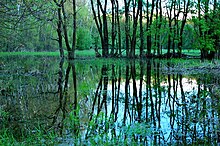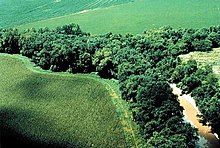|
Riparian forest
 A riparian forest or riparian woodland is a forested or wooded area of land adjacent to a body of water such as a river, stream, pond, lake, marshland, estuary, canal, sink or reservoir. Etymology The term riparian comes from the Latin word ripa, 'river bank'; technically it refers only to areas adjacent to flowing bodies of water such as rivers, streams, sloughs and estuaries. However, the terms riparian forest and riparian zone have come to include areas adjacent to non-flowing bodies of water such as ponds, lakes, playas and reservoirs. Characteristics  Riparian forests are subject to frequent inundation. Riparian forests help control sediment, reduce the damaging effects of flooding and aid in stabilizing stream banks. Riparian zones are transition zones between an upland terrestrial environment and an aquatic environment. Organisms found in this zone are adapted to periodic flooding. Many not only tolerate it, but require it in order to maintain health and complete their lifestyles.[1] ThreatsThreats to riparian forests:
See also
References
External links
|